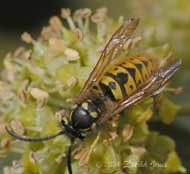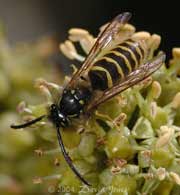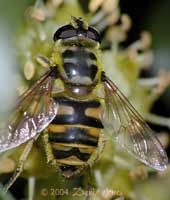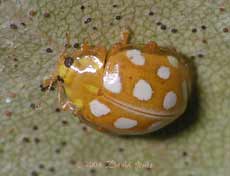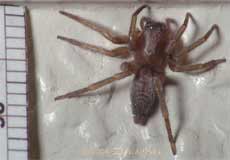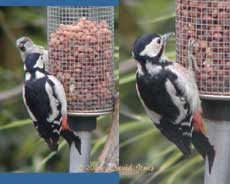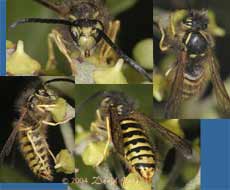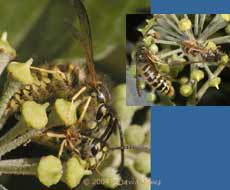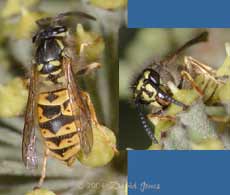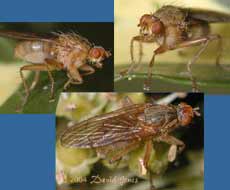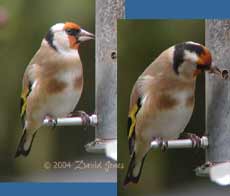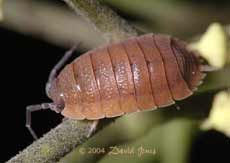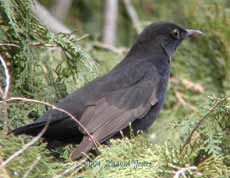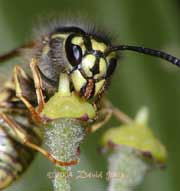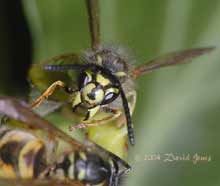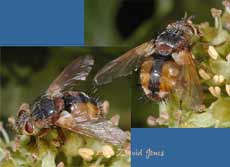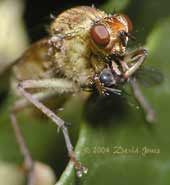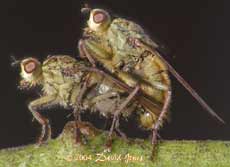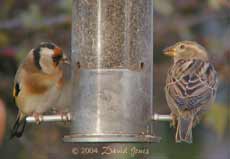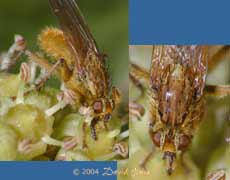Go to latest entry.....................................Go to previous entry24 October - Today there was sunshine during the morning and early afternoon, but as dusk has arrived so has the rain - at 6pm it is pouring down and we have just had thunder and lightning. The mild, sunny conditions encouraged a lot of activity around the Ivy with many flies, hoverflies and wasps maintaining an audible level of noise.
I Think that this one is probably a German Wasp queen. I must take more wasp pictures (especial of their 'faces') to establish whether we have a mixture of Common and German Wasps visiting.
This wasp stood out from the rest when it arrived on the Ivy, with its thin bands of yellow and just two yellow spots at the back of the thorax. Also, its antennae are all black and shiny whereas those of the first wasp are like this only at the bases. The nearest match I can find for this one is Dolichovespula adulterina which is a cuckoo species. I need to check on this ID.
The hoverflies were also busy today, with numerous Eupeodes corollae, Drone-flies, and smaller species. However, this was the only example I saw of the species Myathropa florea, and it is the first time that I have photographed this hoverfly. It is as big as the Drone-flies.
When I got down from the step-ladder I spent some time checking the Birch tree. There wasn't anything new to report on, but the Orange Ladybirds can still be seen the undersides of leaves. I counted twelve this afternoon, including this individual, surrounded by the fungal fruiting bodies (first pictured on 16 October). I could not see any pupae - it looks as though the reproductive cycle is at last over for this year.
Finally, a hunting spider active on a rather dusty(!) bit of wall inside the house. It is a female, about 9mm long, with legs just a little bit longer. I have yet to ID it.
27 October - A cloudy morning has been brightened by another first for the garden. Having spotted the woodpecker in my neighbour's garden on the 19th, this morning I can report the first time I have ever seen one feeding in my garden.
The lack of a red nape patch indicates that this woodpecker is a female.
Also this morning, a Goldfinch has once again started visiting the Thistle-seed feeder. I wonder if this is a sign that the birch seed supply is starting to dry up? 28 October - A day of showers and occasional sunshine. We are getting very gentle weather compared with Cornwall at the moment. This evening the news mentioned that Land's End has experienced severe storm force 11 winds. For the second day high sse winds and the highest tides of the year can't be good news for the Lizard coast.
A large wasp it spent ages on just this one florescence of Ivy flowers. It seems to have yellow on the base of each antenna, and although I can't be sure, the nearest match in my guides is a Wood (or Tree) Wasp (Dolichovespula sylvestis).
When it first arrived there was already a Common was on the flowers, and the Wood Wasp soon encountered it. Usually when two wasps meet there is a flurry of activity and one leaves, but in this case the much larger Wood Wasp seemed to just investigate the other wasp and then both carried on feeding. This happened several times while I watched - the Wood Wasp seemed to be very docile. As you can see, the flowers have completely shed their anthers. The wasps seem to prefer the flowers at this stage. Over the rest of the plant some of the fertilised flowers are already well on their way to forming berries, while others are still to get beyond the bud stage. There are very few leaves left on the Hawthorn and we are now able to see through it. I haven't seen either the Woodpecker of the Goldfinch today, but at least one Dunnock is now a regular visitor under the Hawthorn.
I forgot to include this wasp picture yesterday. A Common Wasp, which has a mal-formed abdominal segment.
29 October - A very dull day, but at least is has stayed mostly dry. I spent a short time watching the Ivy and was surprised to see the Wood Wasp(?) again visiting the same group of flowers. otherwise I can confirm my comments yesterday about the declining numbers of wasps.
The light, mainly orange colouring means they show up clearly against the green. They are about 12mm in length (may be more). I haven't been able to ID it so far.
While I was down at the far end of the garden I was entertained by the high frequency chirping of a flock of Long-tailed Tits as they repeatedly checked out the upper branches of the Birch tree. There was no chance of getting a picture of them, but once I was back indoors I did have better luck with this goldfinch at the thistle feeder.
30 October - A bright, dry day with some interesting observations to record, but first, a couple of things seen last night -
There was also one harvestman (paroligolophus agrestis) and this woodlouse, possibly Androniscus dentiger , although this need to be confirmed.
Today I have spent several sessions on the ladder by the Ivy and the time turned out to be well worth it. First of all, twittering in the conifers beyond the end of the garden turned out to be a couple of Goldcrests, my first definite sightings here since 2002. I dashed back to the house to change my camera set-up but they had disappeared by the time I returned.
Hopefully this one, which appears to be a young male will claim the local territory before next Spring.
On the Ivy the decline in wasp numbers continues, with even less seen today. This one spent ages on one group of flowers, giving me at last a chance to get this close-up of it feeding, nibbling away at the tops of the flowers.
There was a second wasp on the same flower head and they would meet up quite frequently. Here, the second wasp adopts a threatening pose as the wasp pictured above crosses in front of it. There was no contact between them and they both continued feeding.
This fly stood out by virtue of its large size and colour. A look in my guides suggests that it is a Tachina fera (or closely related). This is a fly that prefers woods and moist habitats. It parasitises butterfly and moth larvae. Examples of the orange coloured fly pictured yesterday were in evidence again today. I mentioned that they spend a lot of time perched at leaf edges, and this was the same again today. In fact, although I had seen them walking across flowers I wondered why hadn't managed to see them feeding.
That puzzle was solved this afternoon when I took this picture. It turns out that the fly isn't interested in what the flowers offer, preferring to feed on small flies that visit them. Those time when I see them at the leaf edges they must be waiting to ambush small visitors. Another look through my guides suggests that is is one of the stilt-legged flies (Micropzidae).
It seems that the Ivy is also a place for them to find a mate.
31 October - A bright, sunny day which seemed to end too soon after the clocks went back an hour last night.
By 3.30pm the western end of the garden was heading into shadow as the sun dropped behind the trees. As it dropped, these two visitors at the feeder were lit up by sunlight reflecting off the house.
I only spent a bit of time watching life on the Ivy today. Things seemed very quiet. I only saw a few wasps and a couple of the orange flies.
This individual appears to be much more hairy than the one I pictured eating a fly yesterday. When I look at the mating pair, the male also appears to have a thick coat of orange hairs than his mate, which makes me suspect that today's fly could be a male. Is the fly-eater a female? It had been suggested that the flies are actually dung-flies, although I still do not know the species. Click on images to see larger versions |
|
